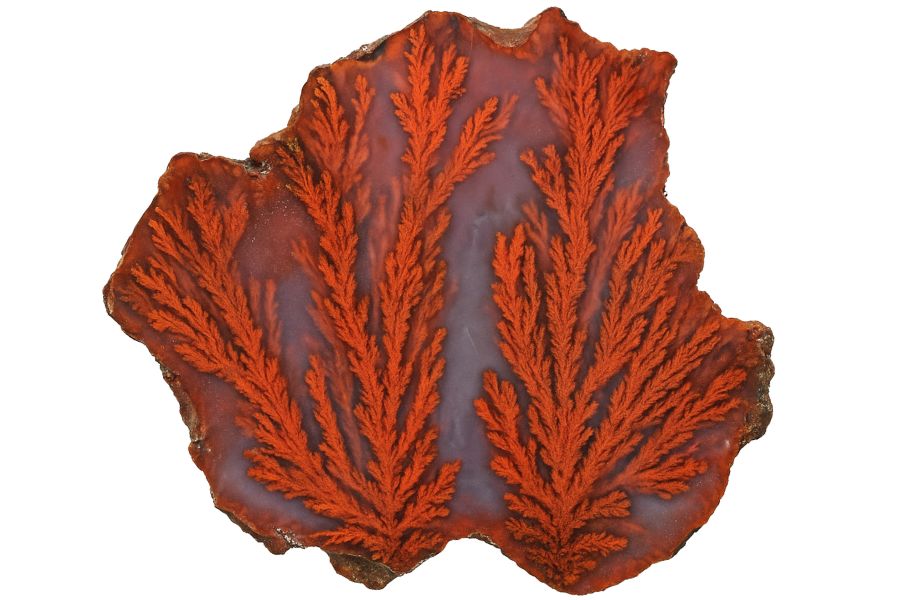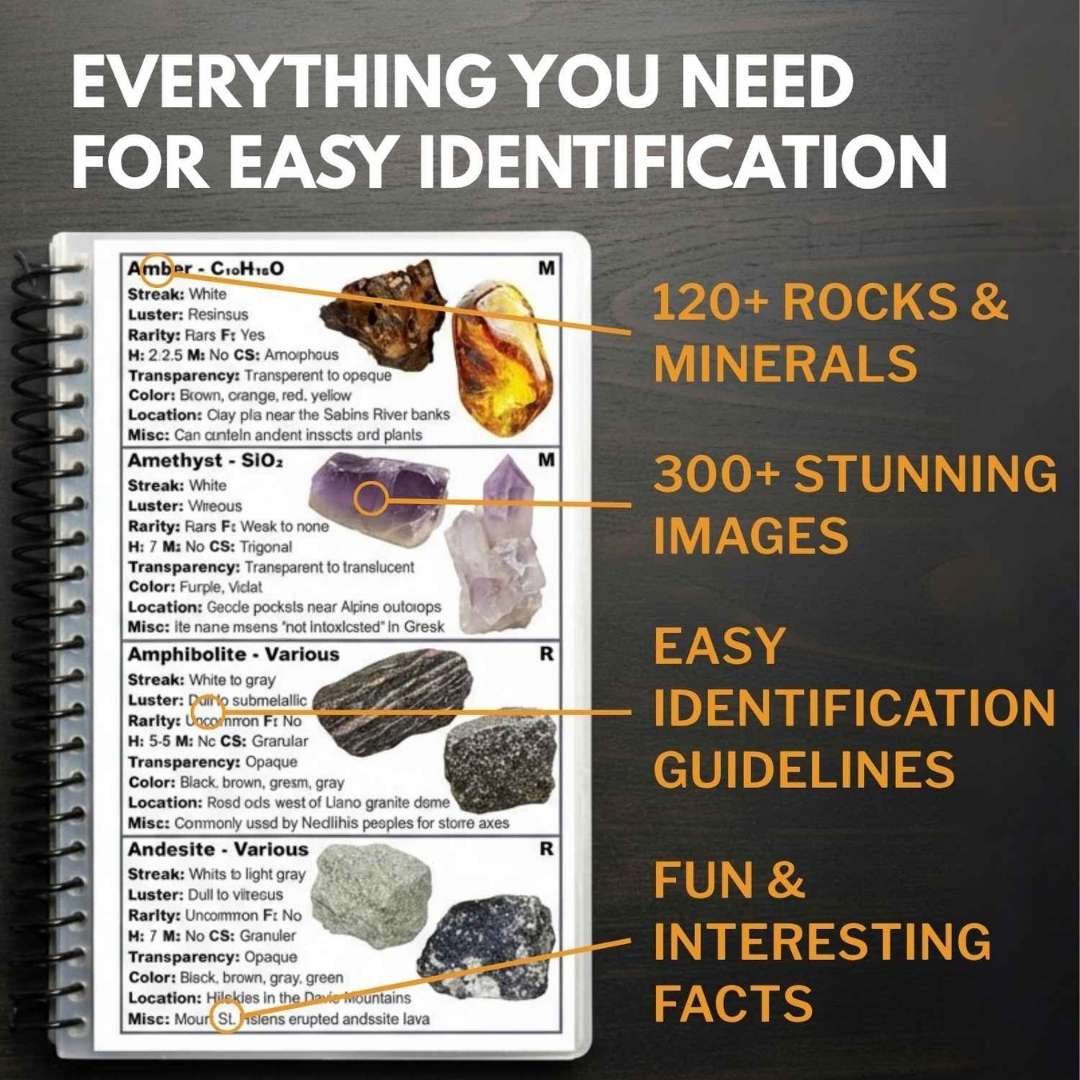There’s something special about finding agates in Texas, where wide open land hides more color than most expect. The state’s deserts and riverbeds hold countless places where these banded stones reveal their beauty after centuries underground.
Old stream beds and exposed hillsides offer plenty of chances to spot agates shimmering in the sun. Ranchlands and dry washes often give up stones that have been freed by erosion, ready for anyone willing to look closely.
Knowing the areas that have produced great finds in the past can make a big difference. With a bit of research and patience, you can come home with a rich mix of shapes and colors that show off the best of Texas agates.
We’ll cover everything you need to know to find them, from proven locations to practical collecting tips. The only thing you’ll want to bring along is the Texas Rocks & Minerals Identification Field Guide, so you can quickly identify every stone you pick up and avoid walking right past a prize without realizing it!
Nothing’s worse than discovering later that you left something incredible behind simply because you didn’t recognize it at the time.
What is Texas Agate?
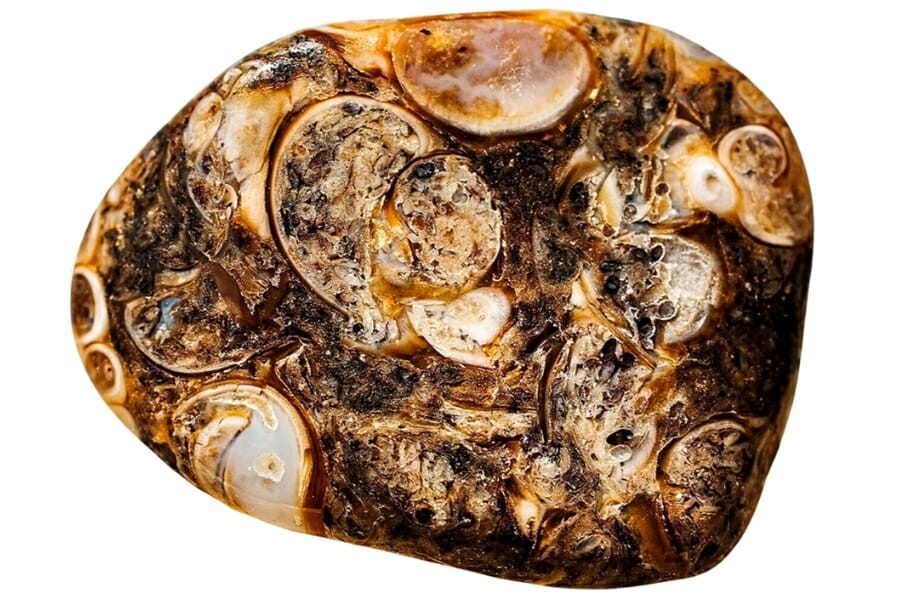
Agate is a type of quartz that’s commonly found everywhere. What makes it special is how it forms in layers, creating all kinds of stunning patterns and colors. Just imagine swirls, stripes, or even spots! The variety is so wide that no two agates are exactly the same.
They form in volcanic rocks or ancient lava flows where there are tiny pockets or holes. Over time, mineral-rich water flows through these holes and leaves behind layers of minerals. The result? A jaw-dropping stone that’s a joy to find and collect! That’s why it’s no surprise that agate is well-valued and prized.
Now, here’s the exciting part: Texas is a treasure trove for agates! Thanks to its rich geology and history of volcanic activity, we are also home to different types of agates.
Blue Lace Agate
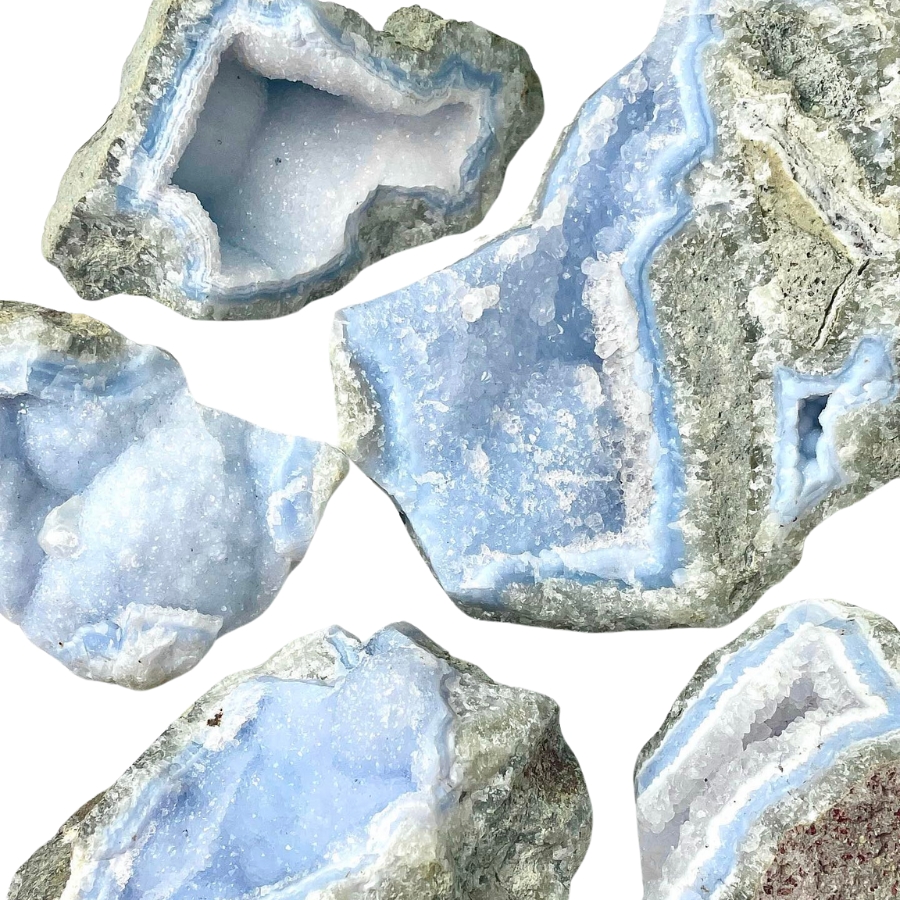
Blue lace agate is like the soft, sky-blue waves with lines that swirl and twist like delicate lace.
Its pattern comes from slow-forming layers of quartz, which create those beautiful, lace-like bands.
The bands of this agate type are often in shades of light blue, white, and sometimes a bit of grey. It’s different from other agates, which usually have more intense colors and stronger patterns.
The value of blue lace agate lies in its soft, tranquil look and the feeling of calm it brings. It’s often used in jewelry or as a decorative stone.
If you want REAL results finding incredible rocks and minerals in Texas you need one of these 👇👇👇
Finding the coolest rocks in Texas isn’t luck, it's knowing what to look for. Thousands of your fellow rock hunters are already carrying Rock Chasing field guides. Maybe it's time you joined the community.
Lightweight, mud-proof, and packed with clear photos, it’s become the go-to tool for anyone interested discovering what’s hidden under our red dirt.
Join them, and make your next rockhounding trip actually pay off.
📘 Order the Texas Field Guide Now →
What makes it different:
🚙 Field-tested across Texas rivers, ranchlands, and roadcuts.
📘 Heavy duty laminated pages resist dust, sweat, and water.
🧠 Zero fluff — just clear visuals and straight-to-the-point info.
📍 Find hidden gems like Blue Topaz, Texas agate, and petrified wood fast.
⭐ Rated 4.8★ by real collectors who actually use it in the field.
Moss Agate
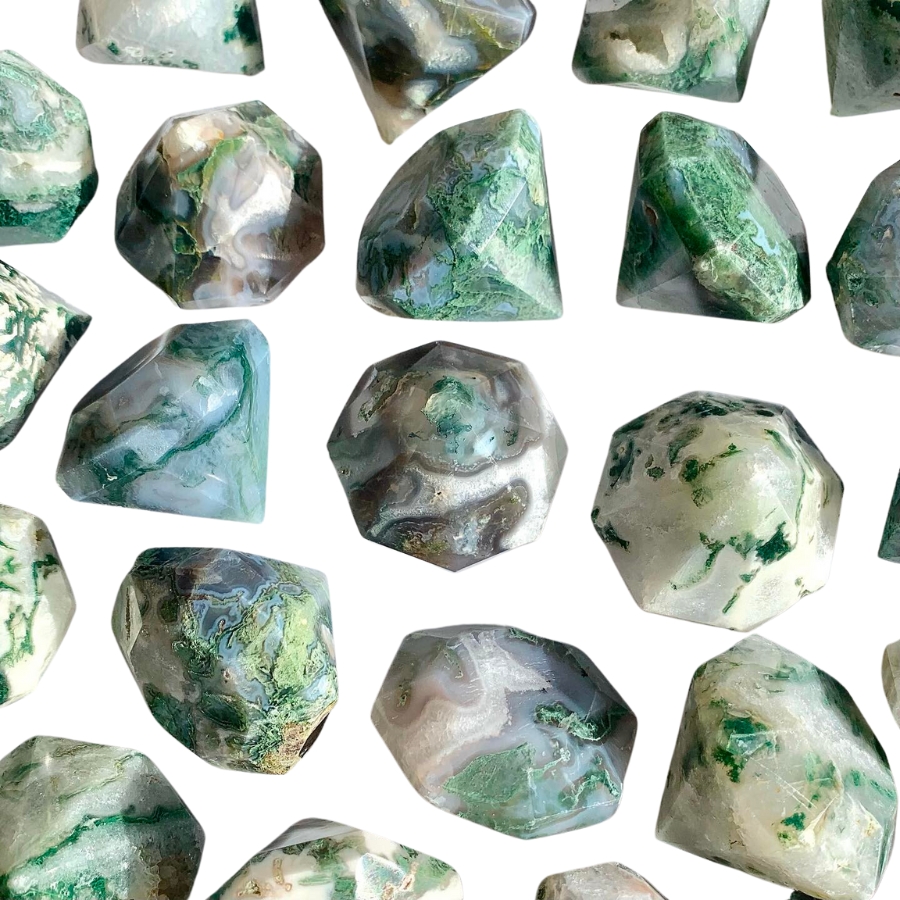
Instead of having the typical banding for which the different types of agates are known, moss agate has green inclusions that look like moss or trees.
These green patterns aren’t real plant material, though. They’re minerals like chlorite or iron oxide.
In some cultures, this type of agate is known as the “gardener’s stone” because of its green, plant-like appearance. It’s believed to help plants grow.
The price of moss agate can vary. It’s often quite affordable, but the more distinct and picturesque the green patterns, the more it might cost.
Fire Agate
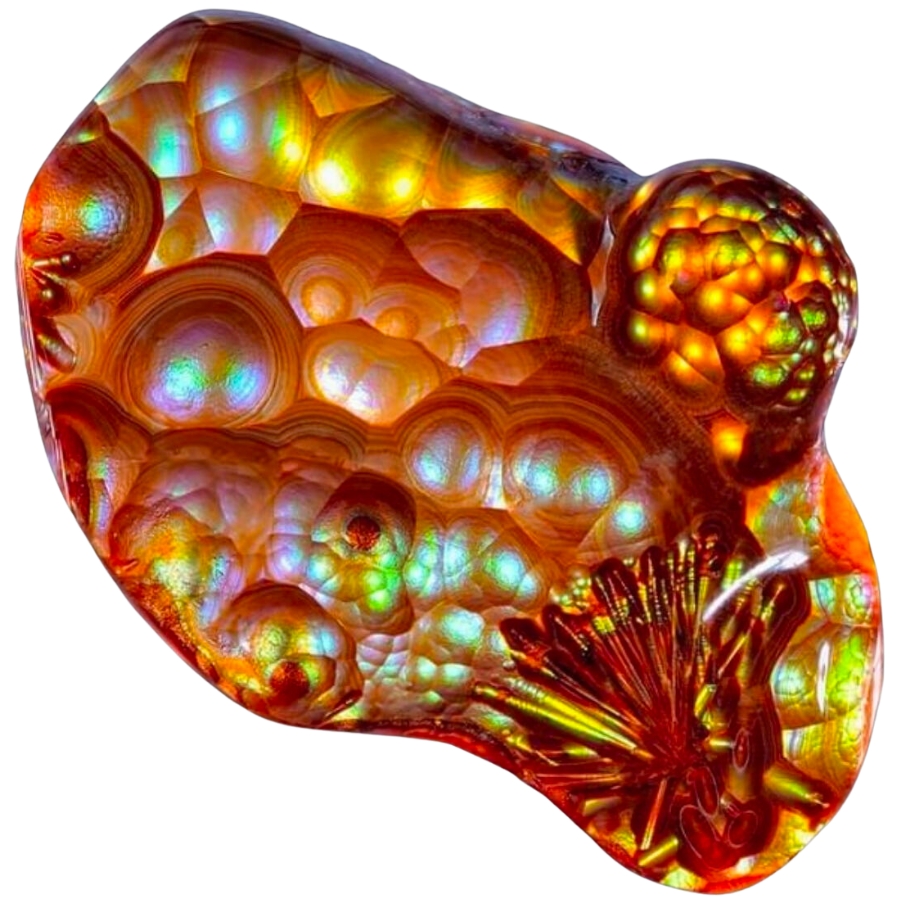
Fire agate is known for its incredible colors and the way it sparkles like fire. It’s got layers of silica and iron oxide that reflect light, creating a fiery effect.
When you look at fire agate, it’s like seeing flames trapped inside. Its colors can range from reds and oranges to greens and golds, all shimmering under the surface.
You might be wondering, “What is fire agate worth?” Well, its value comes from its rare beauty. The more color and sparkle, the more valuable the stone is.
Its fiery iridescence and lively play of color are used in jewelry pieces that are meant to stand out.
Dendritic Agate
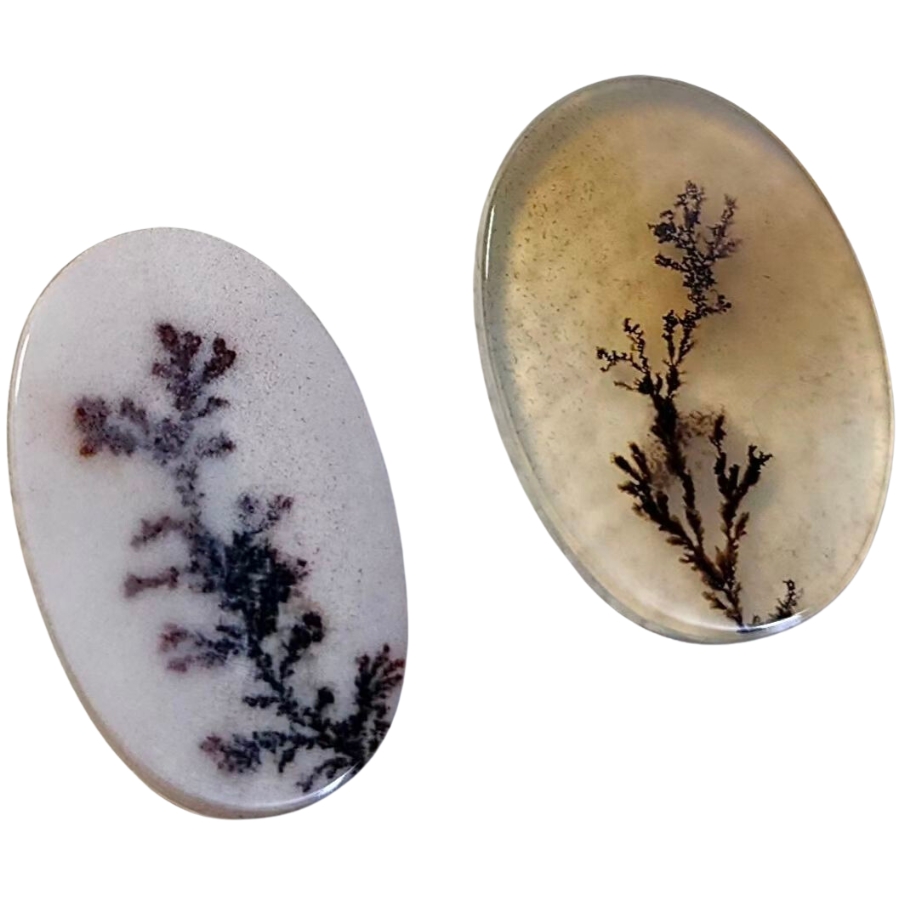
Dendritic agate is known for patterns that look like tiny trees or shrubs. Like moss agate, these patterns aren’t actual plants. They’re made of minerals, mostly manganese or iron oxides.
When you look at a dendritic agate, it’s like peering into a miniature forest or a frosty winter landscape.
The base of the stone is usually translucent to opaque, and the “dendrites”— those tree-like patterns— are often black or brown.
When it comes to how much dendritic agate is worth, it can vary. The more detailed and distinct the patterns are, the more it’s usually valued.
In some cultures, dendritic agate is believed to bring fullness and richness to life.
Crazy Lace Agate
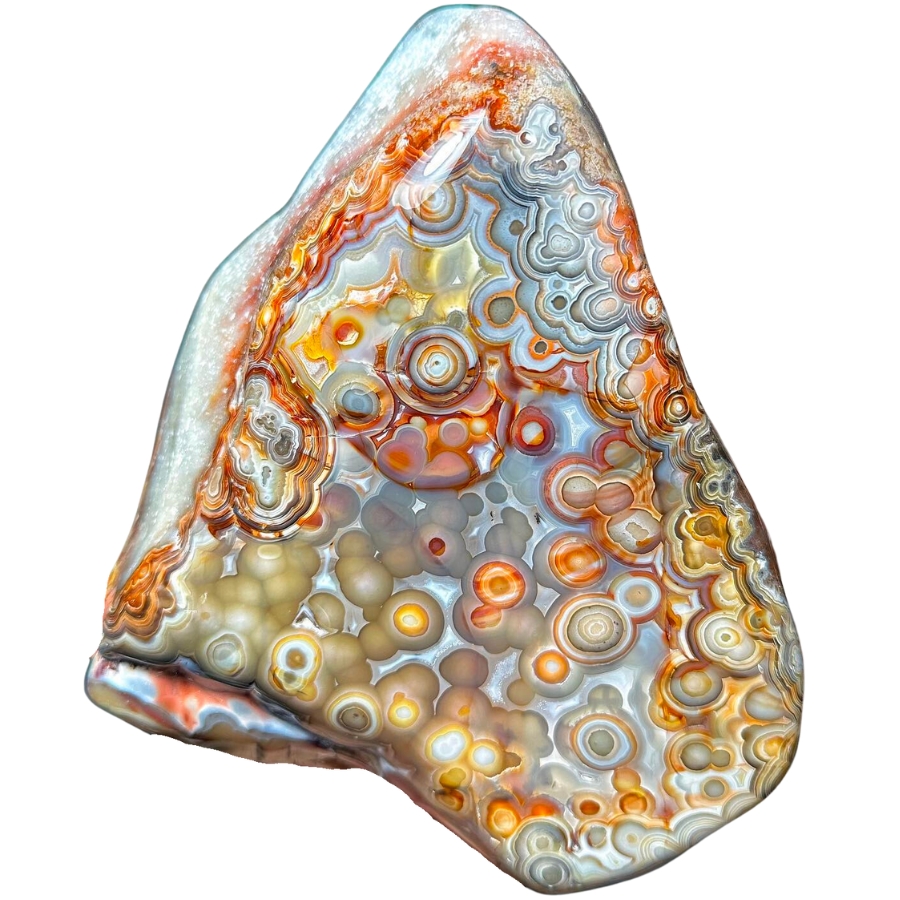
Crazy lace agate is like a party in a rock! It’s got swirls, circles, and all sorts of wild patterns dancing across it.
Its colors can be a mix of red, orange, yellow, and brown, and sometimes even a bit of gray or white.
What makes crazy lace agate stand out is its vibrant and complex patterns. No two pieces are the same. This distinctiveness is a big reason why it’s so valued.
Despite its wild and ‘crazy’ appearance, it’s sometimes called the “Laughter Stone” or “Happy Lace” because of the joy and positive vibes it’s believed to bring.
Laguna Agate
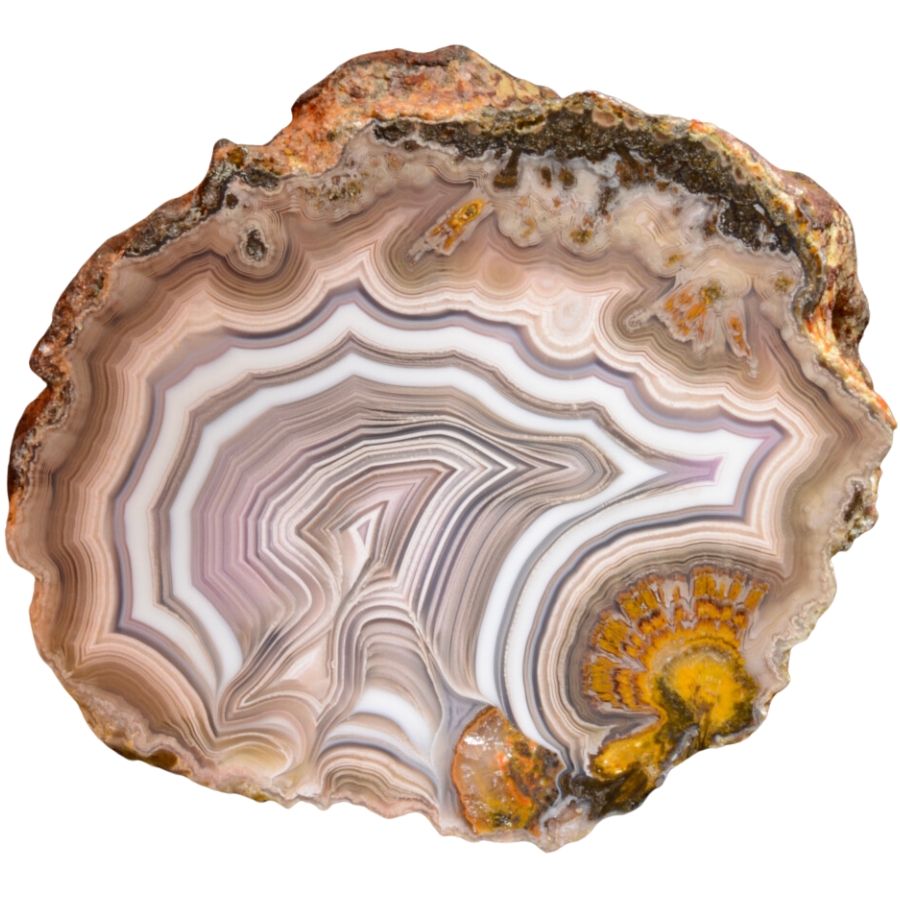
Laguna agate has incredibly sharp and fine banding. It has layers of red, orange, pink, yellow, and sometimes even purple and white all stacked in neat, tight bands.
These bands can form eye-catching patterns, like swirls, loops, and even landscapes.
The different colors of its bands come from various minerals present in the water at the time of its formation.
Laguna agate is considered one of the finest agates in the world due to its exceptional banding. This high regard among agate varieties makes it a prized possession for collectors.
Condor Agate
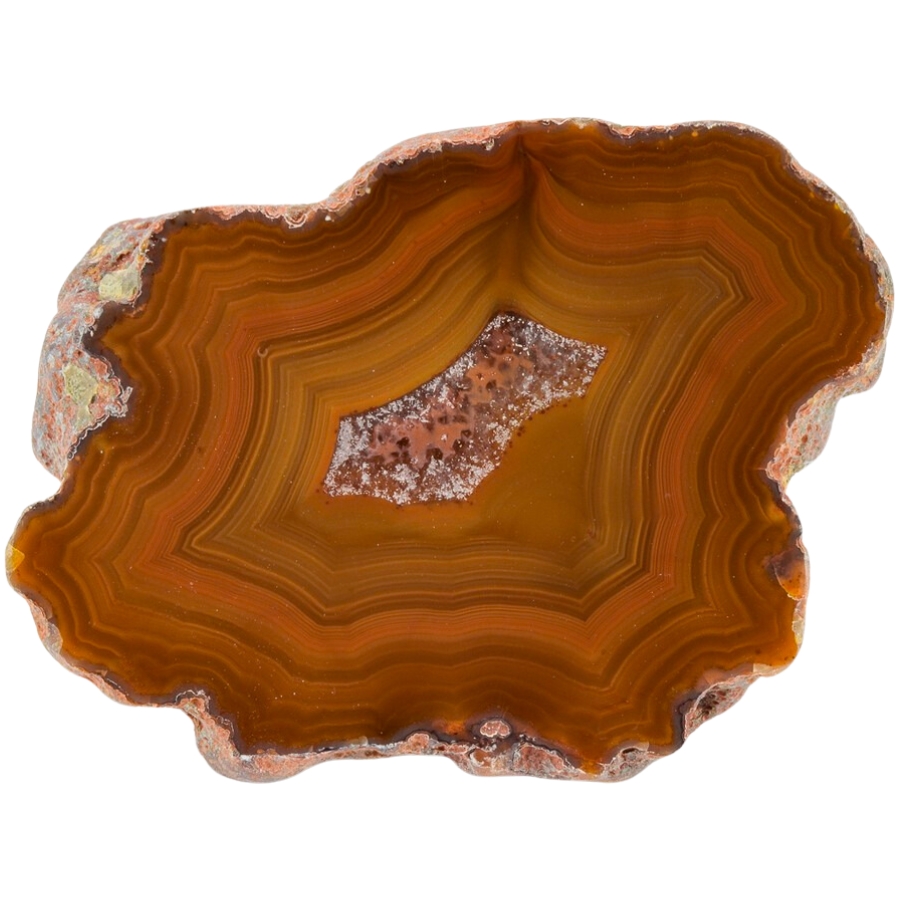
Condor agate is a real standout. It’s known for its bright, vivid colors and complex patterns.
It has reds, oranges, yellows, and sometimes even blues and greens all swirling together. These colors form in bands or in more random, artistic patterns.
The intensity and variety of its colors is what makes condor agate so special. It’s often used by artists and craftsmen who want to make a statement with their work.
Condor agate’s bold colors and patterns can turn a simple piece of jewelry or art into something really eye-catching.
Fortification Agate (Banded Agate)
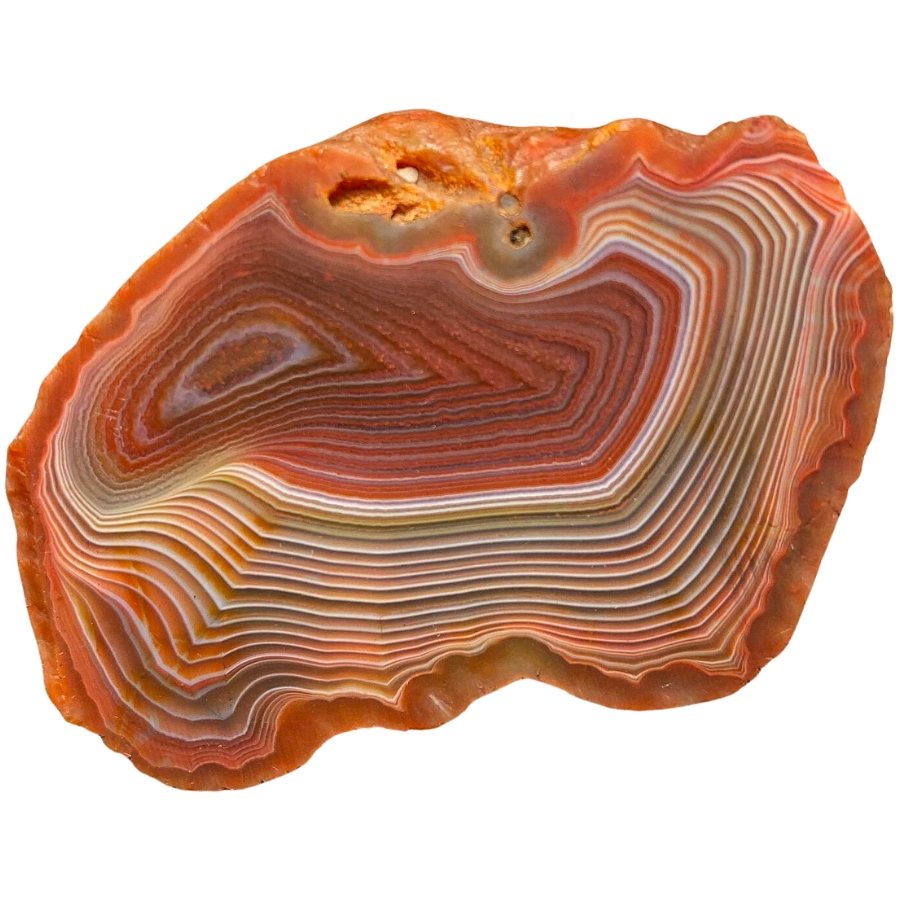
Fortification agate gets its name because the patterns inside it look like the aerial view of a fortified city.
Imagine seeing bands of color forming shapes that look like walls, with sharp angles and curves. They are usually in different colors, making each layer stand out.
If fortification agate is valuable, it’s because of its distinct patterns and colors. Its unique look makes it sought after for jewelry and as a collector’s item.
The clearer and more defined the patterns, the more valuable the stone can be. Some people also believe it can help with relaxation and calmness.
Iris Agate
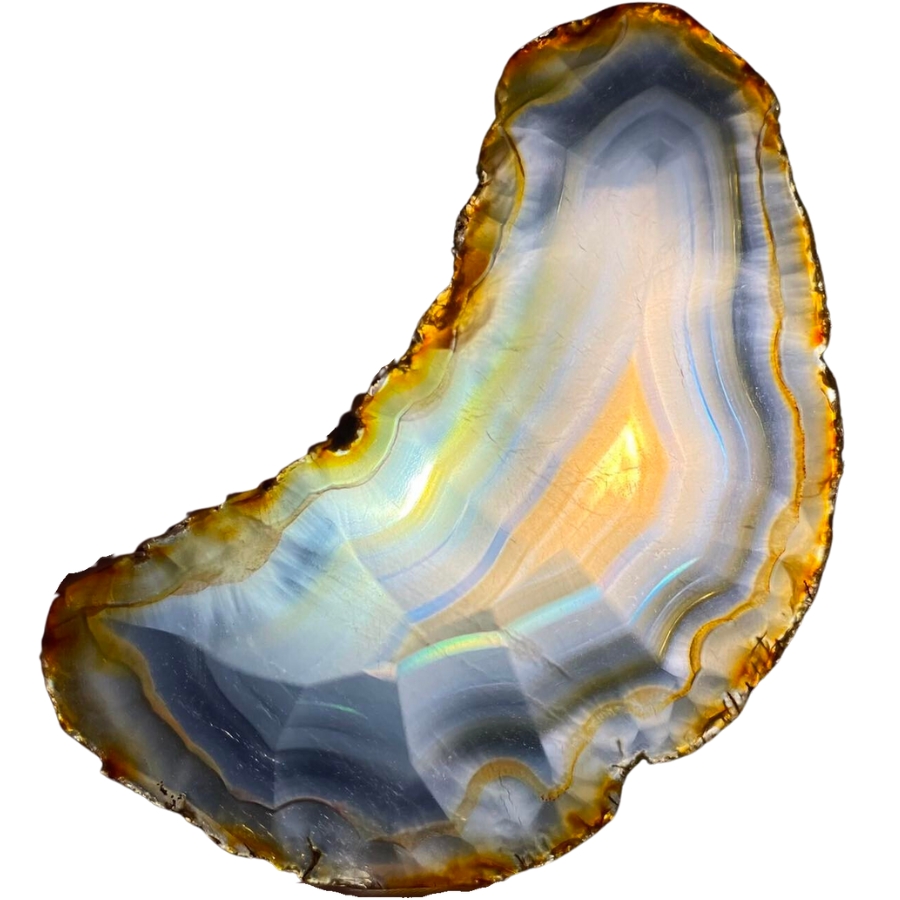
Iris agate looks like a regular agate at first, but when you hold it up to the light, something amazing happens. It shows all these rainbow colors, like light passing through a prism.
This is because it has very thin layers of silica, and when light hits these layers, it splits into all the colors of the rainbow.
The formation of iris agate is similar to other agates, but its layers are super thin, which is what creates the rainbow effect.
The value of iris agate comes from its unique ability to show these colors. In the past, people even used to think it had magical properties because of the way it showed colors. They saw it as a stone of good luck and wonder.
Plume Agate
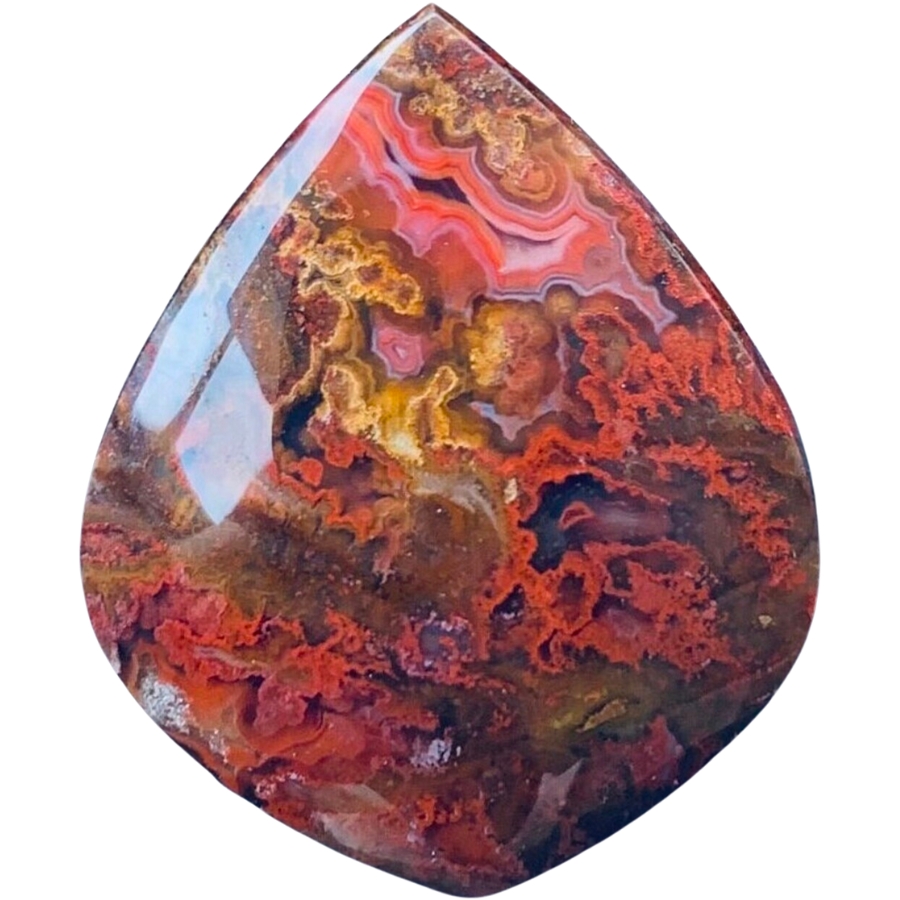
Plume agate gets its name from its patterns that look like soft, feathery plumes. These plumes can be in all sorts of colors: red, black, green, or yellow, set against a translucent or opaque background.
The way these plumes seem to float in the stone makes it look like a frozen underwater scene or like feathers caught in a breeze.
The plumes are made of minerals like manganese or iron oxide, which get trapped in the silica during the agate’s formation and create the feathery patterns.
The price of plume agate can vary depending on how clear and intricate the patterns are. The more detailed and colorful the plumes, the more the stone is usually worth.
Picture Agate (Scenic Agate)
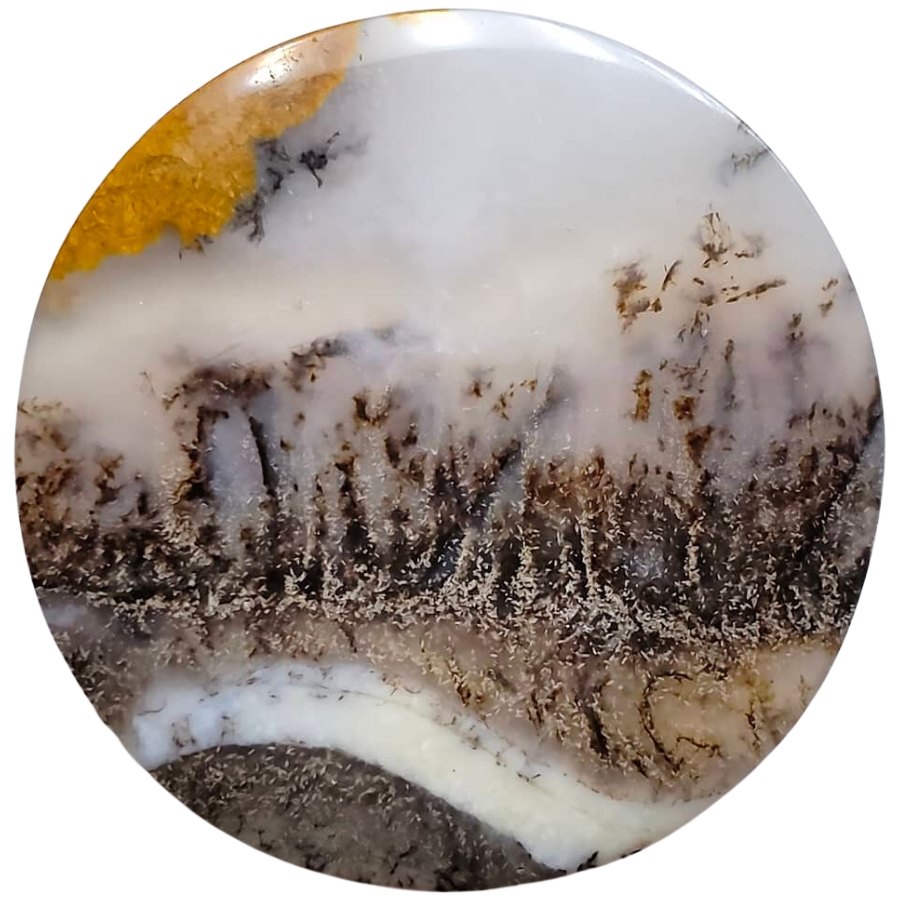
Picture agate is like a snapshot of nature captured in stone because it looks like it has pictures or scenes right inside it.
These “pictures” are actually natural patterns that resemble landscapes, mountains, trees, or even skies. They are usually in different shades of brown, white, and gray against a more translucent background.
The different patterns in picture agate or what’s also called scenic agate are made by various minerals in the water filled with silica that forms it.
If you’re thinking, “What is picture agate worth?“, its value comes from how distinct, clear, and detailed the natural “pictures” are.
Turritella Agate

Turritella agate is not your typical agate because it’s full of fossilized snail shells! The shells belong to a creature called Turritella, a type of sea snail.
These shells are tightly packed and create a pattern that looks like a bunch of tiny, swirling towers. The background of the agate is usually a dark, earthy color, which makes the white or cream-colored snail shells really pop.
Over millions of years, these snail shells got buried in sediment and eventually became fossilized. As time went on, silica-rich water flowed through the sediment, turning it into the agate we see today.
The value of turritella agate comes from its unique blend of geology and history. More than a pretty stone, it’s a piece of ancient life preserved in rock.
Fairburn Agate
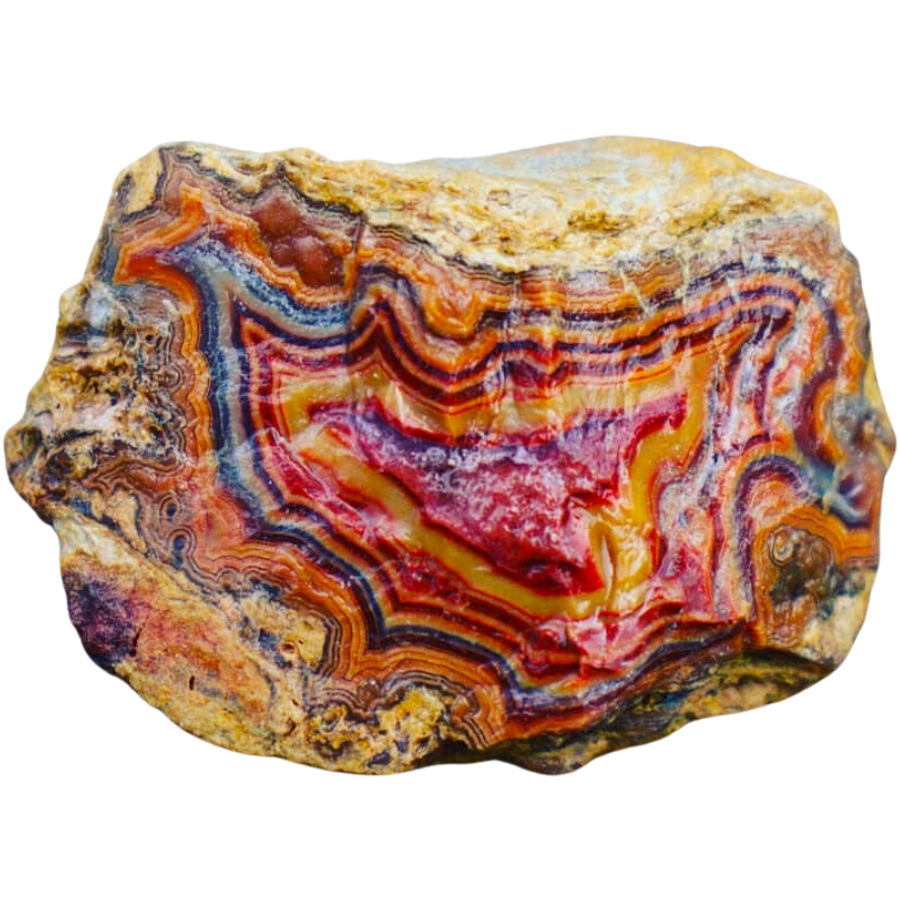
Known for its intricate patterns and bold colors, Fairburn agate is another fascinating type of agate. It usually has bands and swirls of different colors like red, yellow, orange, brown, and sometimes even pink or purple.
What’s special about these patterns is they often look like they’re in layers, creating a 3D effect. It’s like looking at a landscape made of stone.
It’s named after a place called Fairburn in South Dakota. This gives a clue about where it was first discovered.
People value Fairburn agate for the skill it takes to cut and polish it, which makes the patterns and colors really stand out.
Sagenite Agate
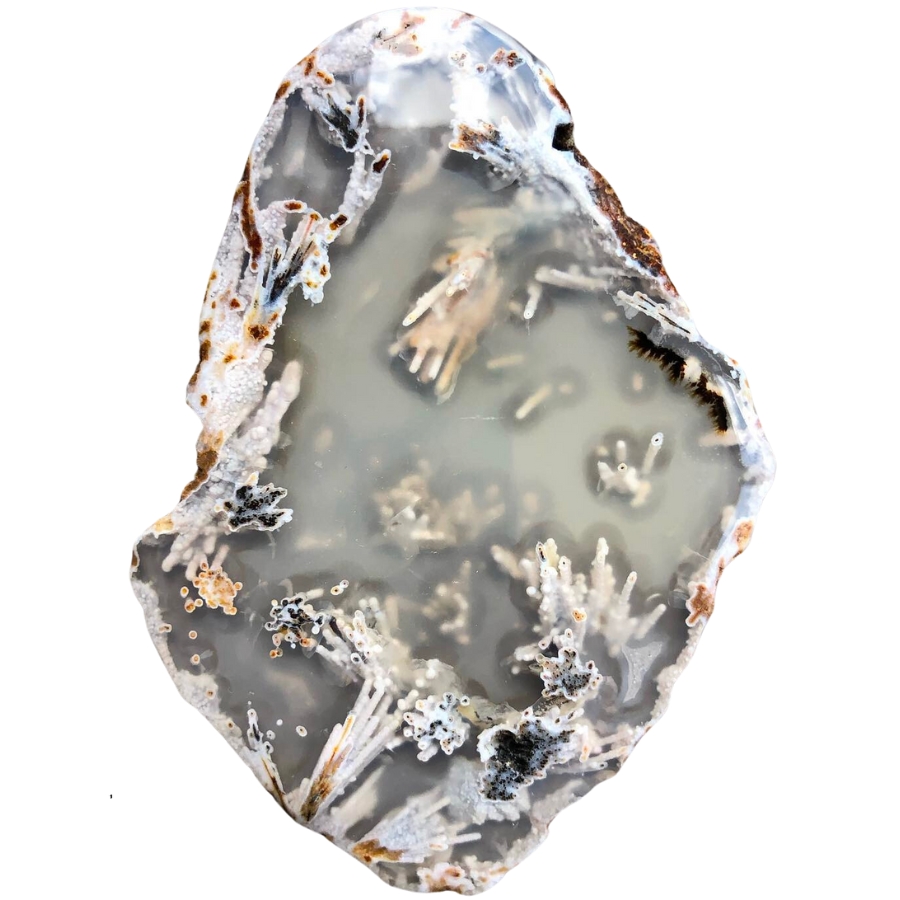
Sagenite agate has needle-like inclusions that look like tiny sprays of crystals inside it. They can be gold, silver, black, or even green, and they spread out in all directions, creating an amazing pattern.
The base of the agate is usually translucent, which lets you see these intricate needle patterns clearly.
These patterns are actually other minerals, like rutile or goethite, that get trapped inside the forming agate. These minerals grow in a crystal shape, looking like needles or hair.
Sagenite agate is often used in jewelry and other decorative items, with some people thinking that its needle patterns look like fireworks or starbursts.
Tree Agate
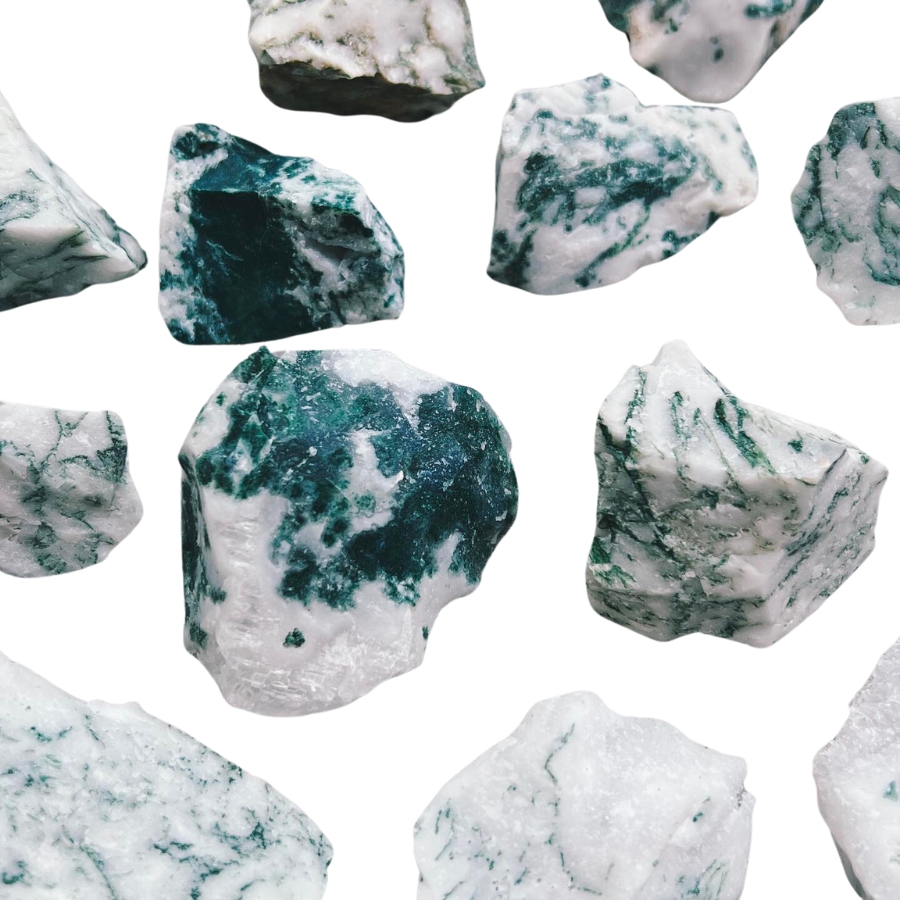
Tree agate, as its name suggests, looks like it’s got tiny trees or branches inside it. These tree-like patterns are usually green and spread out against a white or light gray background.
The green patterns aren’t actual trees, though. They’re made of minerals like chlorite or manganese.
Each piece of tree agate is different. You won’t find two that are exactly the same. It’s valued for its looks and it’s often used in jewelry and decorations.
Tools You Will Need
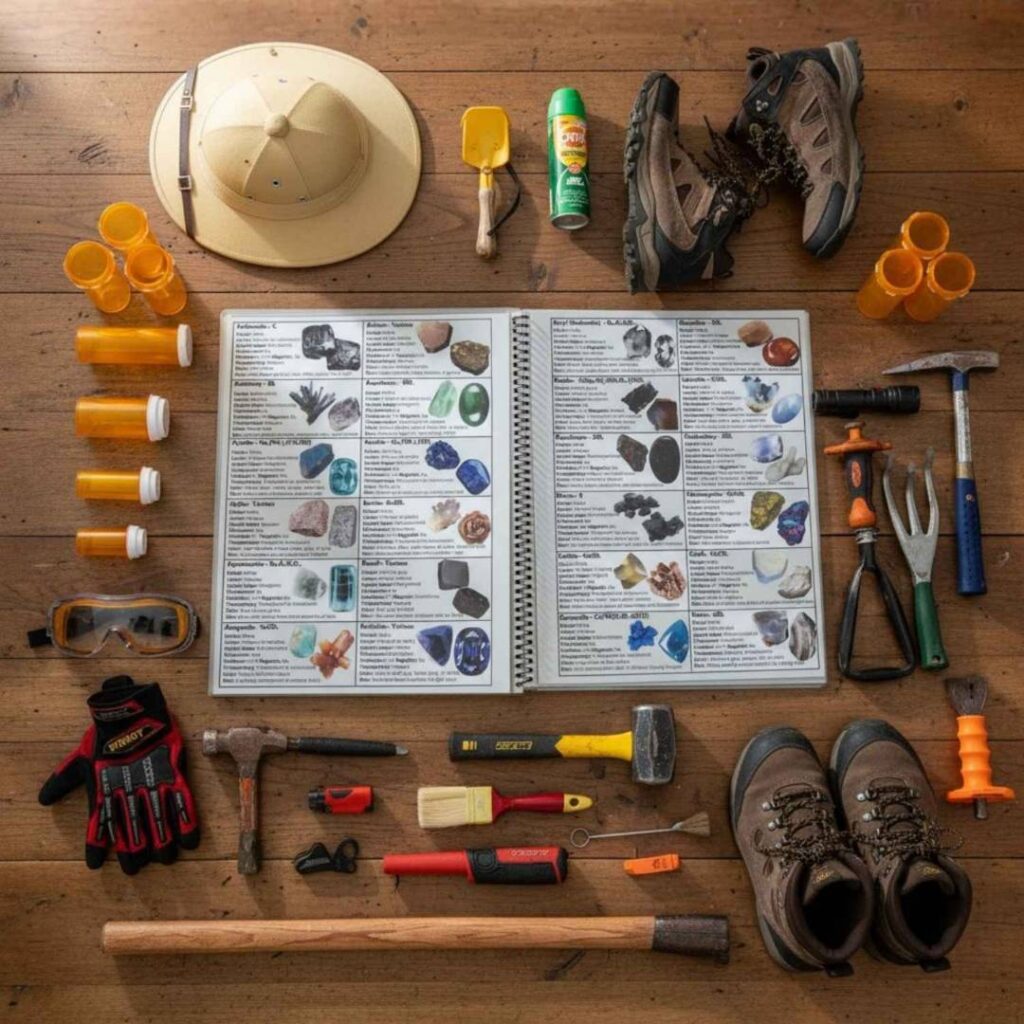
Heading out to hunt for agates in Texas is like going on a hidden treasure adventure. You don’t need fancy gear or a big budget to get started, just a few key tools and a good dose of curiosity.
With the right essentials in your backpack, you’ll be ready to spot colorful agates and other amazing rocks in no time.
A Reliable Field Guide – Essential
A high-quality field guide is the number one thing every beginner should have. It helps you identify what you find, tells you where certain rocks are most common, and teaches you how to tell a regular stone from something special.
Instead of guessing, you’ll know exactly what you’ve discovered, which makes every trip way more rewarding.
If you want a guide made especially for Texas, the Rocks and Minerals of Texas Field Guide is a perfect choice. It’s tough enough to handle dirt and water, filled with clear photos and simple explanations, and lightweight enough to carry anywhere.
With over 120 rocks, crystals, and minerals included, it turns any hike into your own real-life treasure hunt.
Rock Hammer
A rock hammer is your go-to tool for loosening or breaking stones to see what’s inside. You don’t need a professional one, just something sturdy to help you safely tap and examine rocks without damaging them.
It’s great for uncovering hidden patterns, colors, or crystal centers that might be hiding under the surface.
Sturdy Gloves
Protecting your hands is a must while you explore. Rough rocks, cactus spines, and sharp edges can make things uncomfortable fast.
A good pair of gloves keeps your hands safe and lets you handle rocks with confidence while you search riverbeds, trails, and hillsides.
Backpack or Small Bucket
You’ll need something to carry the cool rocks you find. A lightweight backpack or bucket works great for holding your treasures and keeping your hands free to explore.
It’s also handy for carrying water, snacks, and your field guide, so you can stay comfortable out in the Texas sun.
Safety Glasses
If you plan to break open a few rocks, safety glasses are essential. Tiny chips can fly when you use your hammer, and protecting your eyes keeps your adventure safe and worry-free.
They’re simple, inexpensive, and a sign you’re getting serious about exploring responsibly.
The key factors in our recommendations are:
- The deep experience and understanding of our team about the area
- Recommendations from local groups and clubs
- How easy it is to get the a particular location
- Safety and potential hazards when collecting
- Weighing private and public locations
- The ability for both experienced and novice agate enthusiasts to find great samples
With these factors in mind we’ve been able to put together a fantastic list that just about anyone can use!
The Best Spots To Find Agates in Texas

It can be overwhelming to find agates especially since Texas has plenty of great gem mine sites. Don’t worry, though, because below are some of the awesome places that you can explore to find these wonders here:
Always Confirm Access and Collection Rules!
Before heading out to any of the locations on our list you need to confirm access requirements and collection rules for both public and private locations directly with the location. We haven’t personally verified every location and the access requirements and collection rules often change without notice.
Many of the locations we mention will not allow collecting but are still great places for those who love to find beautiful rocks and minerals in the wild without keeping them. We also can’t guarantee you will find anything in these locations since they are constantly changing.
Always get updated information directly from the source ahead of time to ensure responsible rockhounding. If you want even more current options it’s always a good idea to contact local rock and mineral clubs and groups
Brewster County
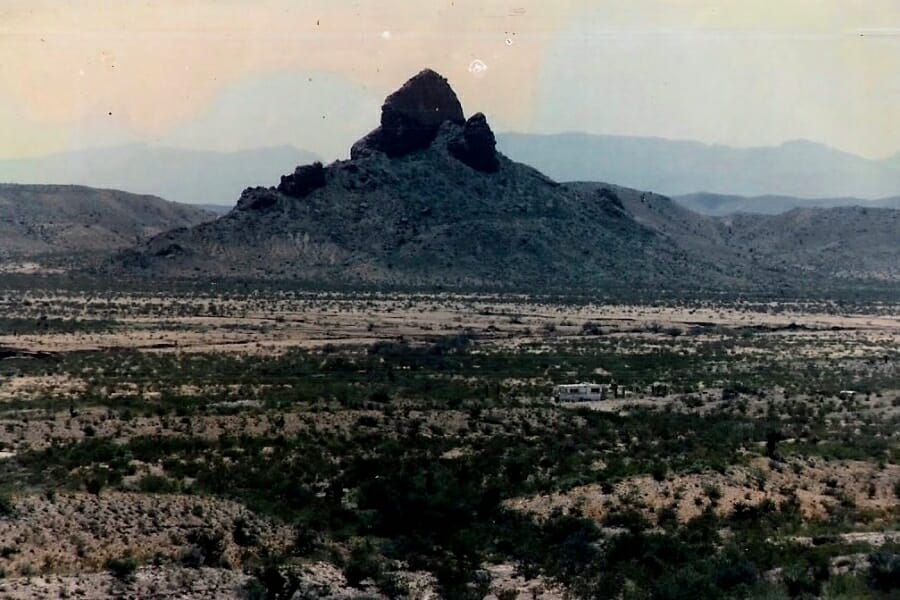
Brewster County, our state’s largest county, offers a mix of mountains, plateaus, and desert terrain. The mighty Chisos Mountains, part of the larger Trans-Pecos region, proudly stand here. These mountains, along with the sprawling deserts, paint a picture of wild beauty and rugged terrain, making it a wonder for anyone who visits.
The geology of Brewster County is like a storybook of our past. Throughout the ages, various natural processes have shaped its terrain and brought to the surface a treasure trove of rocks and minerals, including lovely agates.
While the journey to this county is a bit remote, roads like the U.S. Highway 90 and State Highway 118 make it accessible. It’s always a good idea to review Texas’ latest collecting guidelines before making your trip here.
Where we found agates in Brewster County
If you go to Brewster County specifically to find agates, you’re in luck because there are different amazing places that contain them, such as:
- J. Frank Woodward Ranch
- Agua Fria Ranch
- Needle Peak
- Stillwell Ranch and Trailer Park
- Cretaceous limestones, shales, and dumps in Terlingua
- Bed and banks of Terlingua Creek
- Anderson Ranch
- Henderson Ranch
- Cocoanut Ranch
- Chisos Basin area
You've probably walked past some incredible rocks and minerals. You need this guide 👇👇👇
We've all come across a cool rock that we could have sworn was rare or valuable but couldn't tell what it was.
If you're not 100% confident that you know every rock and mineral in Texas this guide is for you.
The Texas Rocks & Minerals Field Guide helps you ID what you find in seconds, from Hill Country agates to Llano granite, with crisp photos, simple charts, and zero fluff.
→ Grab your copy today and spot your next gem before anyone else does.
What this guide unlocks:
🧭 Confidence in the field — ID rocks fast and move on to the next find
🎒 Lightweight and waterproof — built for trails, not coffee tables
🌅 Weekend adventures — find treasures on rivers, ranches, and roadsides
🤠 Texas pride — explore the real geological beauty of your state
🔥 Motivation — every trip outside feels like a hunt for hidden gems
Lobo Valley
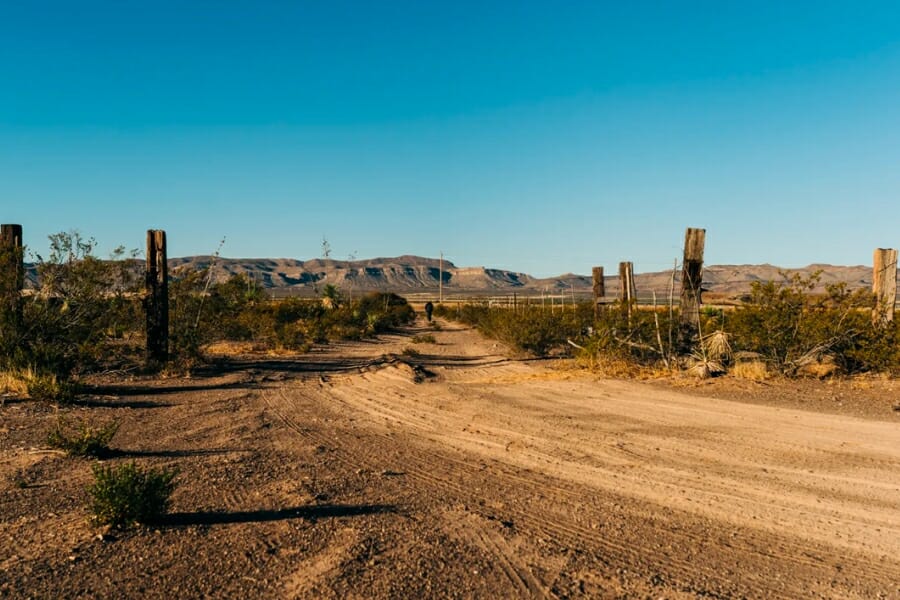
Lobo Valley is surrounded by picturesque landscapes that will make you feel like you’ve stepped into a Wild West movie. With vast expanses of desert terrain, Lobo Valley also has some hilly regions that add a touch of drama to its geography.
Like much of West Texas, Lobo Valley has a rich geological history. Hidden within its terrain are exciting geological treasures, including our beloved agate.
As for reaching Lobo Valley, while it’s not in the middle of a bustling city, it’s reasonably accessible for those with a sense of adventure. The nearby U.S. Highway 90 can lead you in its direction.
Where we found agates in Lobo Valley
Lobo Valley is known as the oldest agate region in Texas, and you can find plume agates in its general area.
Glass Mountains
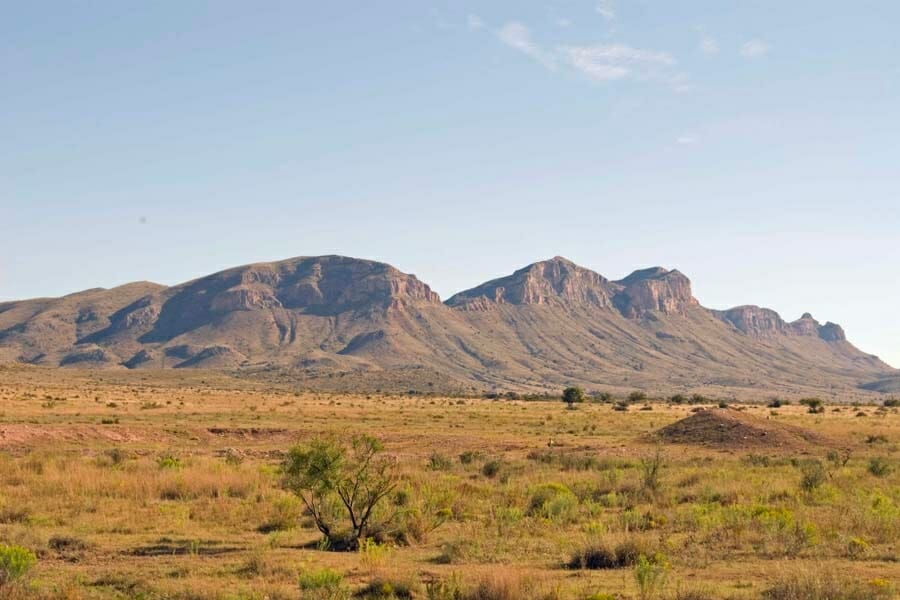
Rising proudly, Glass Mountains get their intriguing name from the shiny, glass-like appearance of some of their rocks. Stretching out across Brewster and Pecos counties, they form a breathtaking backdrop to the desert landscapes below.
These mountains showcase layers upon layers of rock, and one of its standout features is the exposed layers of colorful selenite. Also nestled among these rock layers are other equally stunning wonders like agates.
Traveling to the Glass Mountains is an adventure in itself as the terrain can be rugged. But since it’s situated near U.S. Highway 385, it’s quite accessible if you’re eager enough to reach it.
Where we found agates on the Glass Mountains
You can find amazing samples of moss and plume agates if you explore the west side area of Glass Mountains.
Lake Balmorhea
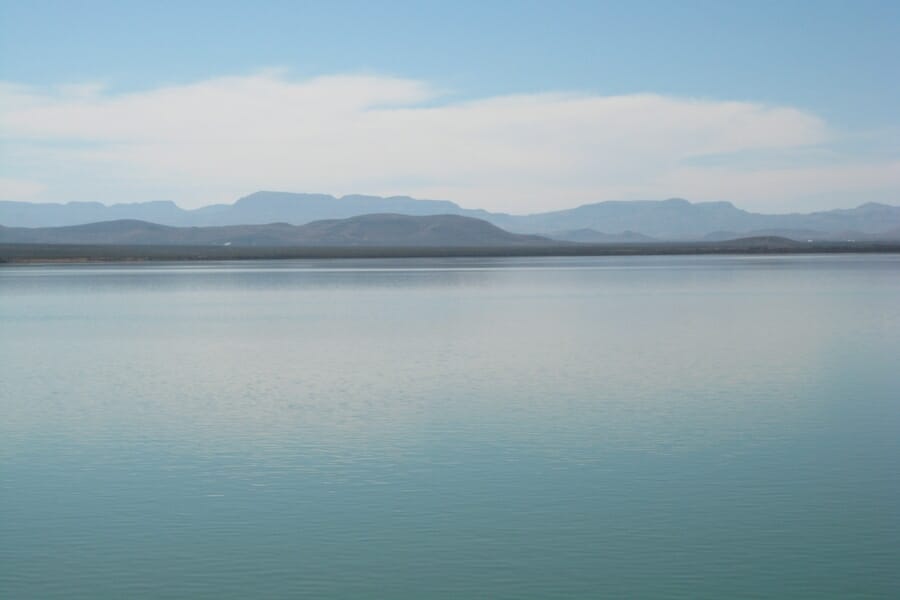
Lake Balmorhea is a man-made reservoir that’s part of the Balmorhea State Park. Fed by San Solomon Springs, the lake’s clear waters are a haven for swimmers, divers, and various aquatic life.
The region around Lake Balmorhea is rich with a mix of limestone and other sedimentary rocks. Thanks to the region’s volcanic history and the flow of mineral-rich waters, agates have found a home around Lake Balmorhea.
To reach this lovely lake, you’ll be happy to know it’s quite accessible. Situated close to State Highway 17, Lake Balmorhea is a welcoming stop for travelers in West Texas.
Where we found agates in Lake Balmorhea
You can find beautiful Balmorhea blue agates if you explore and search through the north and east sides of Lake Balmorhea.
Rio Grande
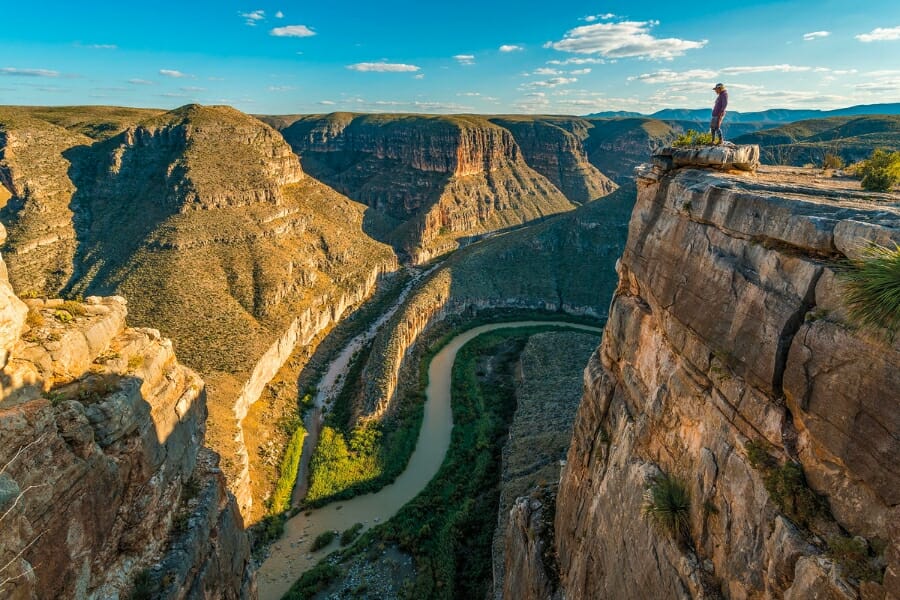
Rio Grande is a mighty river that flows through the heart of Texas, creating a natural border between the United States and Mexico. Stretching over 1,900 miles, it’s one of the longest rivers in North America!
Throughout our state, the Rio Grande winds its way through canyons, deserts, and valleys, giving life to many plants and animals along its path. Its basin and the surrounding areas are a mix of limestone, shale, and sandstone formations.
Getting to the Rio Grande is a breeze, thanks to the many roads and highways that run parallel to it, like U.S. Route 83 and State Highway 170.
Where we found agates in the Rio Grande
You can find Rio Grande agates in all the stream beds and bars of Rio Grande and tributaries.
Other Great Places To Find Agates in Texas
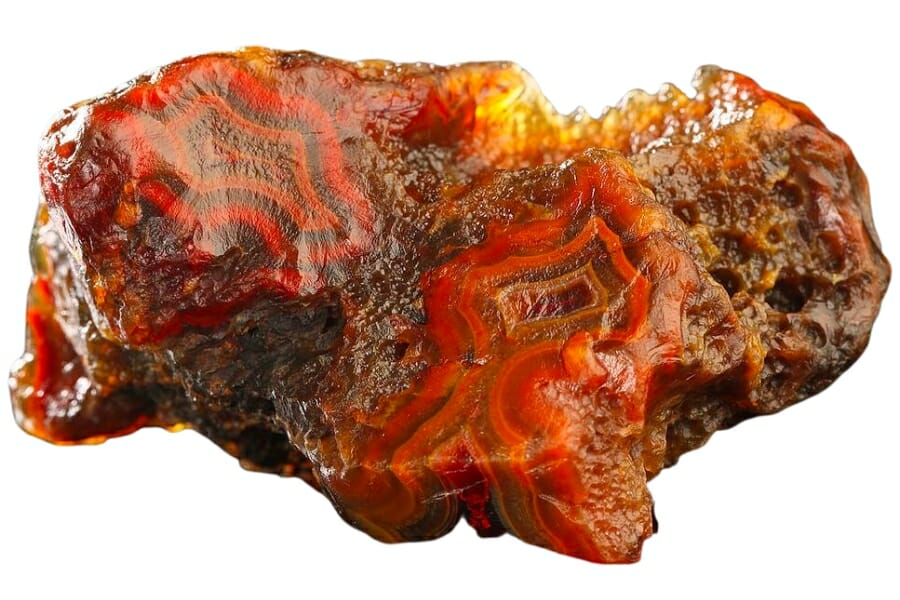
If you want to know about other awesome places where you can find agates in Texas, below are more agate-bearing sites:
Our recommendations by county
| County | Location |
| Bastrop | Wide surrounding region of Smithville especially in breaks, cuts, surfaces |
| Coryell | Limestone area in Gatesville |
| Coryell | Limestone area in Oglesby |
| Coryell | Medart Ranch |
| Culberson | Nickel Creek area wash |
| Duval | County road 44 in Freer area |
| Gonzales | General area farms |
| Gonzales | Bed and banks of Peach Creek |
| Hidalgo | Los Ebanos area |
| Hidalgo | Fordyce Gravel Pits |
| Hudspeth | Quitman Mountains |
| Hudspeth | Broad general region of Allamoore |
| Jeff Davis | Chispa Creek |
| Lavaca | Gravel pits, stream gravels, and farm fields in Moulton |
| Maverick | Helms Ranch |
| Maverick | Cunningham Ranch |
| Maverick | Villarreal Ranch |
| Maverick | Hill Ranch |
| McCullock | Live Oak Creek |
| Pecos | Tunas Creek |
| Pecos | Hovey Ranch |
| Pecos | Sixshooter Draw |
| Presidio | Bishop Ranch |
| Presidio | US-67 all way to Presidio |
| Presidio | Chinati Mountains |
| Presidio | Regional road cuts, breaks, and ranchlands in the Marfa area |
| Reeves | All areas along Barilla Draw |
| Reeves | Ranch roads in Pecos |
| Reeves | All area ranch roads running out of town in Toyah |
| San Patricio | Road cuts, breaks, banks, and gravels in Mathis |
| Trinity | Surrounding areas in cut banks, draws, washes, and slopes of Groveton and Trinity |
| Val Verde | Kothman Ranch |
| Webb | Laredo Gravel Pit |
| Webb | River bars at low water and in gravels of islands in Laredo |
| Webb | Pico Ranch |
| Zapata | Area surfaces and draws of low hills in Lopeno |
| Zapata | Ramirez Ranch |
| Zapata | Bob’s Nob |
Additional areas you can find agates
If you’re having a hard time finding agates even in our recommended areas, make sure to focus your attention on the following specific areas where they usually hide:
Streams and Creeks
Streams and creeks move rocks and minerals from one place to another. The water erodes rocks, breaking off little pieces and carrying them downstream. Over time, these pieces get tumbled and smoothed, turning them into rounded pebbles.
Among these pebbles, you can often find gemstones like agate! When you explore a stream or creek in Texas, there’s a good chance you might stumble upon this beautiful gem.
Rivers and Riverbanks
As rivers move, they churn the ground beneath, unearthing hidden treasures like gemstones. The action of the water washes away softer materials, leaving behind harder rocks, including agate.
Rivers, especially those cutting through areas rich in volcanic rocks, often carry agates with them. The riverbanks then act as resting spots for these gemstones, making them prime locations for discovery.
Lake Shores
Lakeshores are like nature’s jewelry stores, especially in a place as geologically rich as Texas. When rivers and streams flow into lakes, they bring with them a bounty of rocks and minerals. As water currents gently move these rocks, the softer ones break down, while the tougher ones, like agate, remain.
Texas has its fair share of lakes that are surrounded by lands with volcanic history and mineral-rich soil. When you stroll along the lakeshore, the sparkling sands and pebbles underfoot might just be hiding beautiful agates.
Common Agate-Hunting Questions
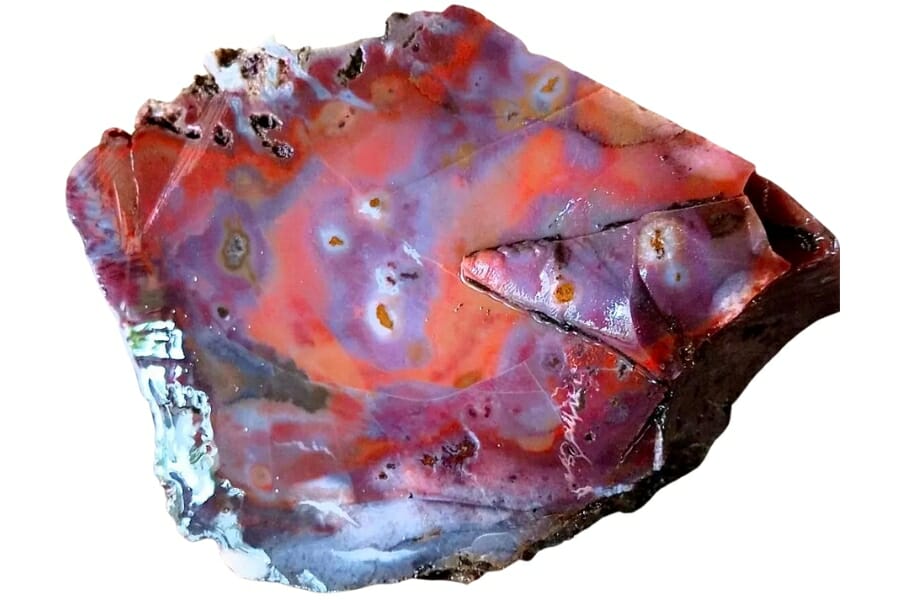
In this section, we’ll share with you the most common question asked by agate hunters in Texas, in case you have the same query in mind:
Is it illegal to collect agate in Texas?
Collecting agates is generally allowed in Texas, but there are important rules to remember. On private land, you must always secure permission from the landowner before collecting.
On state parks or federal lands, rock collecting, including for agates, is typically prohibited without a special permit. However, there are designated public areas and sites where collecting is allowed for personal use.
Always check local regulations and guidelines before setting out on your rockhounding adventure. For more information, visit the official website of the Texas Parks and Wildlife Department (TPWD).
The Best Places To Buy Agates In Texas

If you simply want a more relaxed way of finding, observing, and taking home a Texas agate, you can visit our trusted rock and mineral shops. Below are some of the best ones that we have:
- Enchanted Rocks & Jewelry – 805 Berry St, Llano, TX 78643
- Nature Rocks – 2010 FM2673 Suite 2, Canyon Lake, TX 78133
- Nature’s Treasures Texas – 4103 N Interstate Hwy 35, Austin, TX 78722
- Old Wizzard’s Rock Shop – 14005 African Hill Rd, Willis, TX 77378
- Spirit Quest Rock Gem & Unique Boutique – 303 Main St, Spring, TX 77373
If you have any recommendations for our list please leave a comment below!

